Podcast: Play in new window | Download
Subscribe: Apple Podcasts | RSS
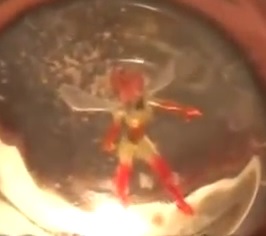 In the summer of 2011, José de la Luz Maldonado, a 22-year-old resident of the San José Rio Verde neighborhood of Guadalajara was out picking guavas with his friends in a small wild grove of fruit trees near his home. From the corner of his eye he saw a sparkle between two branches. José went closer to the source of light and saw what appeared to be a small being. He grabbed it and took it back to his house. By the time he arrived home the small creature had apparently died and was also missing a foot. He put it in a jar full of water and formaldehyde to preserve it. José showed it to his friends and in a few days, people from all around the neighborhood began showing up at his door to see what he had dubbed his “hada madrina” or “fairy godmother.” Lines began to form outside his door and soon a carnival atmosphere developed, with people selling food like churros and gorditas, and trinkets to those waiting outside. José began to charge admission, a few pesos per person to be given as a “donation.” For 20 pesos, or a little over one dollar US, one could take a photo of the fairy. Around 3,000 people showed up to the house over the course of a few weeks. So, what did this fairy look like? The creature stood about a centimeter and a half tall and was mostly red and white in color, with large wings. To some, it looked like a small action figure. To most people who viewed it, however, it was a real fairy and well worth the price of a few pesos to see. Some neighbors even claimed that what José had captured had been buzzing around the neighborhood for weeks. The commotion soon caught the interest of film crews and paranormal investigators. In an interview with Mexican television in his home, José recounted his tale and said that he would not let scientists touch the creature. Would he sell it? No, he told reporters, he planned to either leave it at the Santa Paula Cemetery in the heart of Guadalajara or throw it off the Arseliano Bridge and into the Lerma River. The TV interviewers talked to members of the public in the crowd outside who had chipped in a few pesos and stood on line for an hour to see the alleged fairy. Not a single person interviewed believed that what they saw in José’s home was a fabrication or hoax. When scrutiny became too intense, José announced the viewings of the fairy would cease, and so ended the Guadalajara fairy story. This is not the only such story in Mexico, however.
In the summer of 2011, José de la Luz Maldonado, a 22-year-old resident of the San José Rio Verde neighborhood of Guadalajara was out picking guavas with his friends in a small wild grove of fruit trees near his home. From the corner of his eye he saw a sparkle between two branches. José went closer to the source of light and saw what appeared to be a small being. He grabbed it and took it back to his house. By the time he arrived home the small creature had apparently died and was also missing a foot. He put it in a jar full of water and formaldehyde to preserve it. José showed it to his friends and in a few days, people from all around the neighborhood began showing up at his door to see what he had dubbed his “hada madrina” or “fairy godmother.” Lines began to form outside his door and soon a carnival atmosphere developed, with people selling food like churros and gorditas, and trinkets to those waiting outside. José began to charge admission, a few pesos per person to be given as a “donation.” For 20 pesos, or a little over one dollar US, one could take a photo of the fairy. Around 3,000 people showed up to the house over the course of a few weeks. So, what did this fairy look like? The creature stood about a centimeter and a half tall and was mostly red and white in color, with large wings. To some, it looked like a small action figure. To most people who viewed it, however, it was a real fairy and well worth the price of a few pesos to see. Some neighbors even claimed that what José had captured had been buzzing around the neighborhood for weeks. The commotion soon caught the interest of film crews and paranormal investigators. In an interview with Mexican television in his home, José recounted his tale and said that he would not let scientists touch the creature. Would he sell it? No, he told reporters, he planned to either leave it at the Santa Paula Cemetery in the heart of Guadalajara or throw it off the Arseliano Bridge and into the Lerma River. The TV interviewers talked to members of the public in the crowd outside who had chipped in a few pesos and stood on line for an hour to see the alleged fairy. Not a single person interviewed believed that what they saw in José’s home was a fabrication or hoax. When scrutiny became too intense, José announced the viewings of the fairy would cease, and so ended the Guadalajara fairy story. This is not the only such story in Mexico, however.
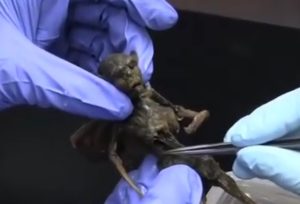 Most cultures throughout the world have stories or folklore involving smaller, magical beings that live secretly among humans. The notion of a Tinkerbell-like fairy, who flies around granting wishes and who serves as an unseen helper of people, is deeply rooted in many Western European cultures, combining Celtic, Germanic and Greco-Roman traditions. The smaller, more familiar winged type of fairy only first appeared in Victorian England. After the 19th Century most all accounts and stories of supposed fairies included descriptions of miniature people with wings, much like the jarred little creature in the colonia in Guadalajara. For most of history in Western Europe, fairies were seen as somewhat malevolent, and eager to play tricks on humans or cause general havoc. It was only during Victorian England and after a marked rise in literacy did fairy stories come out in print and books appeared telling tales of the magical, helpful creatures we can easily recognize today. In the US, Disney ran with the idea of fairies and further developed the modern conception of these mythical creatures. Ancient Mexico had its own beliefs regarding unseen little people that closely approximate what many would consider members of a fairy race, and those ancient beliefs are still held by some people living in Mexico to this day. These creatures are called aluxes and chaneques. To learn more about the alux and the chaneque, please see Mexico Unexplained Episode Number 59.
Most cultures throughout the world have stories or folklore involving smaller, magical beings that live secretly among humans. The notion of a Tinkerbell-like fairy, who flies around granting wishes and who serves as an unseen helper of people, is deeply rooted in many Western European cultures, combining Celtic, Germanic and Greco-Roman traditions. The smaller, more familiar winged type of fairy only first appeared in Victorian England. After the 19th Century most all accounts and stories of supposed fairies included descriptions of miniature people with wings, much like the jarred little creature in the colonia in Guadalajara. For most of history in Western Europe, fairies were seen as somewhat malevolent, and eager to play tricks on humans or cause general havoc. It was only during Victorian England and after a marked rise in literacy did fairy stories come out in print and books appeared telling tales of the magical, helpful creatures we can easily recognize today. In the US, Disney ran with the idea of fairies and further developed the modern conception of these mythical creatures. Ancient Mexico had its own beliefs regarding unseen little people that closely approximate what many would consider members of a fairy race, and those ancient beliefs are still held by some people living in Mexico to this day. These creatures are called aluxes and chaneques. To learn more about the alux and the chaneque, please see Mexico Unexplained Episode Number 59.
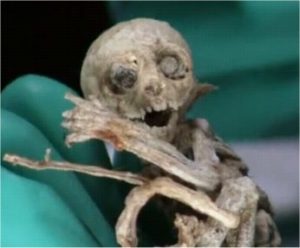 On May 26, 2007 on a ranch outside the town of Metepec in the central Mexican state of Mexico a strange creature was captured in an animal trap. The following month it was brought to the attention of the Mexican public by consummate paranormal investigator Jaime Maussan, host of the television show “Tercer Milenio.” A film crew went out to the Metepec ranch and that began the formal investigation. The creature was hunched over and measured about 8 inches long, had human features and characteristics except for a long tail, and sharp, angry-looking teeth. There was no evidence of wings but people still thought it was a fairy or some other creature that has not yet been identified. The being, dubbed by Jaime Maussan, “The Creature of Metepec,” was poked and prodded and its DNA was sent to various labs. During this investigation, something curious happened which only added to the bizarre nature of the story. The discoverer of this creature was found dead. His car was abandoned and then his body was found a few days later burned, almost beyond recognition. Some alleged that he was killed by other similar creatures who exacted revenge and were angry at the fact that one of their own had been killed by the animal trap. Others believed that the man was killed to cover up the real story behind this supposed fairy being. The five labs investigating “The Creature of Metepec” came up with different conclusions. One lab said that some of the DNA was human. Three of the five labs said their testing was inconclusive, one going so far as to say that the DNA was from a “yet unknown animal.” The remaining lab came to a solid conclusion: the DNA was from a small female Mexican monkey, a kind of spider monkey called a mono titi in Spanish. Many researchers contended that DNA analysis was inconclusive in this case because the creature had been handled so many times and that the DNA was contaminated and untestable. The television show “Tercer Milenio” offered the owners of the alleged fairy 300,000 pesos to purchase it, but they declined. The body of the creature ended up missing and no further investigations on this strange fairly-like animal were conducted.
On May 26, 2007 on a ranch outside the town of Metepec in the central Mexican state of Mexico a strange creature was captured in an animal trap. The following month it was brought to the attention of the Mexican public by consummate paranormal investigator Jaime Maussan, host of the television show “Tercer Milenio.” A film crew went out to the Metepec ranch and that began the formal investigation. The creature was hunched over and measured about 8 inches long, had human features and characteristics except for a long tail, and sharp, angry-looking teeth. There was no evidence of wings but people still thought it was a fairy or some other creature that has not yet been identified. The being, dubbed by Jaime Maussan, “The Creature of Metepec,” was poked and prodded and its DNA was sent to various labs. During this investigation, something curious happened which only added to the bizarre nature of the story. The discoverer of this creature was found dead. His car was abandoned and then his body was found a few days later burned, almost beyond recognition. Some alleged that he was killed by other similar creatures who exacted revenge and were angry at the fact that one of their own had been killed by the animal trap. Others believed that the man was killed to cover up the real story behind this supposed fairy being. The five labs investigating “The Creature of Metepec” came up with different conclusions. One lab said that some of the DNA was human. Three of the five labs said their testing was inconclusive, one going so far as to say that the DNA was from a “yet unknown animal.” The remaining lab came to a solid conclusion: the DNA was from a small female Mexican monkey, a kind of spider monkey called a mono titi in Spanish. Many researchers contended that DNA analysis was inconclusive in this case because the creature had been handled so many times and that the DNA was contaminated and untestable. The television show “Tercer Milenio” offered the owners of the alleged fairy 300,000 pesos to purchase it, but they declined. The body of the creature ended up missing and no further investigations on this strange fairly-like animal were conducted.
 Perhaps the most famous case of modern Mexican fairies was showcased on the television show “¡Nuestro día!” seen by millions of Mexicans on the now-defunct Cadenatres television network. Based in Mexico City, Cadenatres also had affiliates in three populous border towns: Ciudad Juárez, Mexicali and Nogales. On the show – which aired on Friday, January 11, 2013 – paranormal investigator Ana Luisa Cid brought a cotton-lined box and a story about its contents. The four hosts of the show, comfortable in the living-room-like feel of the studio, asked Ana Luisa Cid pointed questions of what they were about to see and she was happy to tell the story. This “fairy tale” began sometime in the year 2010 in the state of Mexico in a wooded area near the municipality of Tultitlán. A hearing impaired boy was wandering in the woods when his hearing aid began to act up. There was some sort of static and then the boy heard voices of children. He followed a road to try to find out where the voices were coming from and the boy soon found himself in a part of the forest that had been recently scorched by a forest fire. Among the charred remains of the trees and underbrush, the boy found two small bodies. Thinking they were rare animals, he took them home. About a year and a half later, the boy’s family contacted Ana Luisa Cid to have the creatures investigated. Cid enlisted the help of biologist Dr. Enrique Ortiz Carreón of SOS Health Laboratory who started his examinations in the boy’s home. Dr. Ortiz then took samples and later put the creatures through a series of tests in his lab, notably, radiographs, x-rays, magnetic resonance and pathological analysis. After giving sufficient background, Ana Luisa Cid removed the lid on the box she brought to the show and revealed what she had been talking about. Inside the box was
Perhaps the most famous case of modern Mexican fairies was showcased on the television show “¡Nuestro día!” seen by millions of Mexicans on the now-defunct Cadenatres television network. Based in Mexico City, Cadenatres also had affiliates in three populous border towns: Ciudad Juárez, Mexicali and Nogales. On the show – which aired on Friday, January 11, 2013 – paranormal investigator Ana Luisa Cid brought a cotton-lined box and a story about its contents. The four hosts of the show, comfortable in the living-room-like feel of the studio, asked Ana Luisa Cid pointed questions of what they were about to see and she was happy to tell the story. This “fairy tale” began sometime in the year 2010 in the state of Mexico in a wooded area near the municipality of Tultitlán. A hearing impaired boy was wandering in the woods when his hearing aid began to act up. There was some sort of static and then the boy heard voices of children. He followed a road to try to find out where the voices were coming from and the boy soon found himself in a part of the forest that had been recently scorched by a forest fire. Among the charred remains of the trees and underbrush, the boy found two small bodies. Thinking they were rare animals, he took them home. About a year and a half later, the boy’s family contacted Ana Luisa Cid to have the creatures investigated. Cid enlisted the help of biologist Dr. Enrique Ortiz Carreón of SOS Health Laboratory who started his examinations in the boy’s home. Dr. Ortiz then took samples and later put the creatures through a series of tests in his lab, notably, radiographs, x-rays, magnetic resonance and pathological analysis. After giving sufficient background, Ana Luisa Cid removed the lid on the box she brought to the show and revealed what she had been talking about. Inside the box was 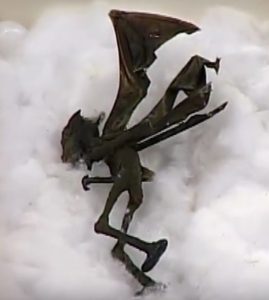 what appeared to be the charred or mummified remains of a small humanoid with two sets of wings and characteristics and features that were remarkably human. The two sets of wings included an upper set of larger wings like those of a bat and a secondary set of wings much like those found on a beetle. The facial features of the creature looked like that of a person except the ears were higher in the head and the mouth had sharp teeth. Cid theorized that the fairy was a carnivore and had teeth like that to eat insects and the flesh of small animals. The creature had thin, extended legs. It was unclear whether this fairy was male or female. The hosts and Ana Luisa Cid began to theorize about what exactly they were looking at. Cid explained that x-rays revealed that the creature was one piece and wasn’t made of parts of other animals and insects cobbled together to make a new creature. The x-rays showed bones and that the wings were reinforced by cartilage. Tests showed that the “fairy” was definitely organic. The family enlisted the help of investigators at UCLA, but researchers at the university wanted to cut apart the fairies and destroy them, so the family said “no” to this more invasive analysis. Ana Luisa Cid also enlisted the help of a man named Antonio Vázquez Alba, known as “El Brujo Mayor,” or “The Head Warlock,” in English, a researcher of paranormal phenomena and other dimensions. When Vázquez approached the creatures he sensed brain activity in one of them. As a self-proclaimed “vibrations specialist,” he said he could sense a high intelligence in the creature and that it was a “real, thinking being.” Rather than go down the extraterrestrial route, El Brujo Mayor sensed that the fairies were extra-dimensional and came from
what appeared to be the charred or mummified remains of a small humanoid with two sets of wings and characteristics and features that were remarkably human. The two sets of wings included an upper set of larger wings like those of a bat and a secondary set of wings much like those found on a beetle. The facial features of the creature looked like that of a person except the ears were higher in the head and the mouth had sharp teeth. Cid theorized that the fairy was a carnivore and had teeth like that to eat insects and the flesh of small animals. The creature had thin, extended legs. It was unclear whether this fairy was male or female. The hosts and Ana Luisa Cid began to theorize about what exactly they were looking at. Cid explained that x-rays revealed that the creature was one piece and wasn’t made of parts of other animals and insects cobbled together to make a new creature. The x-rays showed bones and that the wings were reinforced by cartilage. Tests showed that the “fairy” was definitely organic. The family enlisted the help of investigators at UCLA, but researchers at the university wanted to cut apart the fairies and destroy them, so the family said “no” to this more invasive analysis. Ana Luisa Cid also enlisted the help of a man named Antonio Vázquez Alba, known as “El Brujo Mayor,” or “The Head Warlock,” in English, a researcher of paranormal phenomena and other dimensions. When Vázquez approached the creatures he sensed brain activity in one of them. As a self-proclaimed “vibrations specialist,” he said he could sense a high intelligence in the creature and that it was a “real, thinking being.” Rather than go down the extraterrestrial route, El Brujo Mayor sensed that the fairies were extra-dimensional and came from 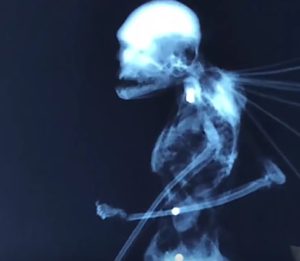 another dimension. At the end of the “¡Nuestro día!” show – which was one of the most popular episodes in the brief history of the program – Cid announced a viewing of the creatures at a small rental hall in the Colonia Roma area of Mexico City the following day. Admission for children was 100 pesos and for adults, 200 pesos. After this public viewing in January of 2013 nothing more was heard of these fairies and the phenomena just seemed to end. Given the rarity of fairy sightings in Mexico and the disappearance of most of the evidence surrounding cases of fairies, one might want to think seriously about whether or not these are all just poorly conducted hoaxes on a gullible Mexican public… or maybe not.
another dimension. At the end of the “¡Nuestro día!” show – which was one of the most popular episodes in the brief history of the program – Cid announced a viewing of the creatures at a small rental hall in the Colonia Roma area of Mexico City the following day. Admission for children was 100 pesos and for adults, 200 pesos. After this public viewing in January of 2013 nothing more was heard of these fairies and the phenomena just seemed to end. Given the rarity of fairy sightings in Mexico and the disappearance of most of the evidence surrounding cases of fairies, one might want to think seriously about whether or not these are all just poorly conducted hoaxes on a gullible Mexican public… or maybe not.
REFERENCES
Summers, Ken. “Tinkerbell Flies South: Mexican Man Claims to Capture Real Fairy in Bottle.” In Week in Weird (website), 26 Aug. 2011.
Ana Luisa Cid Blog (in Spanish)
Tercer Milenio Web site (in Spanish)
“Ser de Metepec” entry on web site Wiki Pseudociencia (in Spanish)

3 thoughts on “Mexican Fairies”
WOW….this is weird! Very interesting…
Yes, that is why we come to listen to the programs at Mexico Unexplained. 🙂
Can I get names of Americans who seen these creature